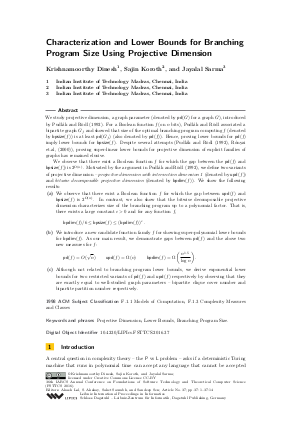Characterization and Lower Bounds for Branching Program Size Using Projective Dimension
Authors Krishnamoorthy Dinesh, Sajin Koroth, Jayalal Sarma
-
Part of:
Volume:
36th IARCS Annual Conference on Foundations of Software Technology and Theoretical Computer Science (FSTTCS 2016)
Part of: Series: Leibniz International Proceedings in Informatics (LIPIcs)
Part of: Conference: IARCS Annual Conference on Foundations of Software Technology and Theoretical Computer Science (FSTTCS) - License:
 Creative Commons Attribution 3.0 Unported license
Creative Commons Attribution 3.0 Unported license
- Publication Date: 2016-12-10
File

PDF
LIPIcs.FSTTCS.2016.37.pdf
- Filesize: 0.53 MB
- 14 pages
Document Identifiers
Subject Classification
Keywords
- Projective Dimension
- Lower Bounds
- Branching Program Size
Metrics
- Access Statistics
-
Total Accesses (updated on a weekly basis)
0Document
0Metadata
Abstract
We study projective dimension, a graph parameter (denoted by pd(G) for a graph G), introduced by Pudlak and Rodl (1992). For a Boolean function f(on n bits), Pudlak and Rodl associated a bipartite graph G_f and showed that size of the optimal branching program computing f (denoted by bpsize(f)) is at least pd(G_f) (also denoted by pd(f)). Hence, proving lower bounds for pd(f) imply lower bounds for bpsize(f). Despite several attempts (Pudlak and Rodl (1992), Ronyai et.al, (2000)), proving super-linear lower bounds for projective dimension of explicit families of graphs has remained elusive.
We observe that there exist a Boolean function f for which the gap between the pd(f) and bpsize(f) is 2^{Omega(n)}. Motivated by the argument in Pudlak and Rodl (1992), we define two variants of projective dimension - projective dimension with intersection dimension 1 (denoted by upd(f)) and {bitwise decomposable projective dimension} (denoted by bpdim(f)). We show the following results:
(a) We observe that there exist a Boolean function f for which the gap between upd(f) and bpsize(f) is 2^{Omega(n)}. In contrast, we also show that the bitwise decomposable projective dimension characterizes size of the branching program up to a polynomial factor. That is, there exists a large constant c>0 and for any function f, bpdim(f)/6 <= bpsize(f) <= (bpdim(f))^c.
(b) We introduce a new candidate function family f for showing super-polynomial lower bounds for bpdim(f). As our main result, we demonstrate gaps between pd(f) and the above two new measures for f: pd(f) = O(sqrt{n}), upd(f) = Omega(n), bpdim(f) = Omega({n^{1.5}}/{log(n)}).
(c) Although not related to branching program lower bounds, we derive exponential lower bounds for two restricted variants of pd(f) and upd(f) respectively by observing that they are exactly equal to well-studied graph parameters - bipartite clique cover number and bipartite partition number respectively.
Cite As Get BibTex
Krishnamoorthy Dinesh, Sajin Koroth, and Jayalal Sarma. Characterization and Lower Bounds for Branching Program Size Using Projective Dimension. In 36th IARCS Annual Conference on Foundations of Software Technology and Theoretical Computer Science (FSTTCS 2016). Leibniz International Proceedings in Informatics (LIPIcs), Volume 65, pp. 37:1-37:14, Schloss Dagstuhl – Leibniz-Zentrum für Informatik (2016)
https://doi.org/10.4230/LIPIcs.FSTTCS.2016.37
BibTex
@InProceedings{dinesh_et_al:LIPIcs.FSTTCS.2016.37,
author = {Dinesh, Krishnamoorthy and Koroth, Sajin and Sarma, Jayalal},
title = {{Characterization and Lower Bounds for Branching Program Size Using Projective Dimension}},
booktitle = {36th IARCS Annual Conference on Foundations of Software Technology and Theoretical Computer Science (FSTTCS 2016)},
pages = {37:1--37:14},
series = {Leibniz International Proceedings in Informatics (LIPIcs)},
ISBN = {978-3-95977-027-9},
ISSN = {1868-8969},
year = {2016},
volume = {65},
editor = {Lal, Akash and Akshay, S. and Saurabh, Saket and Sen, Sandeep},
publisher = {Schloss Dagstuhl -- Leibniz-Zentrum f{\"u}r Informatik},
address = {Dagstuhl, Germany},
URL = {https://drops.dagstuhl.de/entities/document/10.4230/LIPIcs.FSTTCS.2016.37},
URN = {urn:nbn:de:0030-drops-68722},
doi = {10.4230/LIPIcs.FSTTCS.2016.37},
annote = {Keywords: Projective Dimension, Lower Bounds, Branching Program Size}
}
Author Details
References
- Paul Beame, Nathan Grosshans, Pierre McKenzie, and Luc Segoufin. Nondeterminism and an abstract formulation of Nečiporuk’s lower bound method. CoRR, abs/1608.01932, 2016. URL: http://arxiv.org/abs/1608.01932.
-
Béla Bollobás. Random Graphs, Second edition. Cambridge Studies in Advanced Mathematics 73. Cambridge University Press, 2001.

- Philippe Delsarte. Association schemes and t-designs in regular semilattices. Journal of Combinatorial Theory, Series A, 20(2):230-243, mar 1976. URL: http://dx.doi.org/10.1016/0097-3165(76)90017-0.
- Péter Frankl and Ronald L. Graham. Intersection theorems for vector spaces. European Journal of Combinatorics, 6(2):183-187, jun 1985. URL: http://dx.doi.org/10.1016/s0195-6698(85)80009-3.
- Péter Frankl and Richard M. Wilson. The Erdős-Ko-Rado theorem for vector spaces. Journal of Combinatorial Theory Series A, 43(2):228-236, nov 1986. URL: http://dx.doi.org/10.1016/0097-3165(86)90063-4.
-
Stasys Jukna. Boolean Function Complexity: Advances and Frontiers, volume 27 of Series: Algorithms and Combinatorics. Springer New York Inc., 2012.

- Dinesh Krishnamoorthy, Sajin Koroth, and Jayalal Sarma. Characterization and lower bounds for branching program size using projective dimension. CoRR, abs/1604.07200, 2016. URL: http://arxiv.org/abs/1604.07200.
-
Eyal Kushilevitz and Noam Nisan. Communication Complexity. Cambridge University Press, New York, NY, USA, 1997.

- Satyanarayana V. Lokam. Complexity lower bounds using linear algebra. Foundations and Trends in Theoretical Computer Science, 4(1&2):1-155, January 2009. URL: http://dx.doi.org/10.1561/0400000011.
- Benjian Lv and Kaishun Wang. The eigenvalues of q-Kneser graphs. Discrete Mathematics, 312(6):1144-1147, 2012. URL: http://dx.doi.org/10.1016/j.disc.2011.11.042.
-
E. I. Nečiporuk. On a boolean function. Doklady of the Academy of Sciences of the USSR, 164(4):765-766, 1966.

- P. Pudlák and V. Rödl. A combinatorial approach to complexity. Combinatorica, 12:221-226, 1992. URL: http://dx.doi.org/10.1007/BF01204724.
- P. Pudlák and V. Rödl. Some combinatorial-algebraic problems from complexity theory. Discrete Mathematics, 136(1-3):253-279, dec 1994. URL: http://dx.doi.org/10.1016/0012-365x(94)00115-y.
-
Omer Reingold. Undirected connectivity in log-space. Journal of the ACM, 55(4):17:1-17:24, September 2008.

-
Lajos Rónyai, László Babai, and Murali K. Ganapathy. On the number of zero-patterns of a sequence of polynomials. Journal of the AMS, 14:2001, 2002.

-
Heribert Vollmer. Introduction to Circuit Complexity: A Uniform Approach. Springer New York Inc., 1999.

